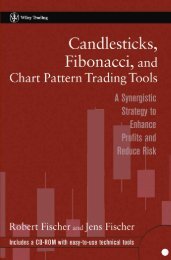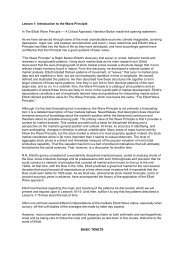The Ultimate Technical Analysis Handbook - Tradingportalen.com
The Ultimate Technical Analysis Handbook - Tradingportalen.com
The Ultimate Technical Analysis Handbook - Tradingportalen.com
You also want an ePaper? Increase the reach of your titles
YUMPU automatically turns print PDFs into web optimized ePapers that Google loves.
Chapter 1 — How the Wave Principle Can Improve Your Trading<br />
Every trader, every analyst and every technician has favorite techniques to use when trading. But where traditional<br />
technical studies fall short, the Wave Principle kicks in to show high probability price targets. Just as<br />
important, it can distinguish high probability trade setups from the ones that traders should ignore.<br />
Where <strong>Technical</strong> Studies Fall Short<br />
<strong>The</strong>re are three categories of technical studies: trend-following indicators, oscillators and sentiment indicators.<br />
Trend-following indicators include moving averages, Moving Average Convergence-Divergence (MACD)<br />
and Directional Movement Index (ADX). A few of the more popular oscillators many traders use today are<br />
Stochastics, Rate-of-Change and the Commodity Channel Index (CCI). Sentiment indicators include Put-Call<br />
ratios and Commitment of Traders report data.<br />
<strong>Technical</strong> studies like these do a good job of illuminating the way for traders, yet they each fall short for one<br />
major reason: they limit the scope of a trader’s understanding of current price action and how it relates to the<br />
overall picture of a market. For example, let’s say the MACD reading in XYZ stock is positive, indicating<br />
the trend is up. That’s useful information, but wouldn’t it be more useful if it could also help to answer these<br />
questions: Is this a new trend or an old trend? If the trend is up, how far will it go? Most technical studies<br />
simply don’t reveal pertinent information such as the maturity of a trend and a definable price target – but the<br />
Wave Principle does.<br />
How Does the Wave Principle Improve Trading?<br />
Here are five ways the Wave Principle improves trading:<br />
1. Identifies Trend<br />
<strong>The</strong> Wave Principle identifies the direction of the dominant trend. A five-wave advance identifies the<br />
overall trend as up. Conversely, a five-wave decline determines that the larger trend is down. Why is<br />
this information important? Because it is easier to trade in the direction of the dominant trend, since it<br />
is the path of least resistance and undoubtedly explains the saying, “the trend is your friend.” Simply<br />
put, the probability of a successful <strong>com</strong>modity trade is much greater if a trader is long Soybeans when<br />
the other grains are rallying.<br />
2. Identifies Countertrend<br />
<strong>The</strong> Wave Principle also identifies countertrend moves. <strong>The</strong> three-wave pattern is a corrective response<br />
to the preceding impulse wave. Knowing that a recent move in price is merely a correction within a<br />
larger trending market is especially important for traders, because corrections are opportunities for<br />
traders to position themselves in the direction of the larger trend of a market.<br />
<strong>The</strong> <strong>Ultimate</strong> <strong>Technical</strong> <strong>Analysis</strong> <strong>Handbook</strong> — © 2009 Elliott Wave International<br />
This ebook includes handpicked lessons from more than 200 pages of EWI’s <strong>com</strong>prehensive<br />
Trader’s Classroom Collection of eBooks. Learn more here: http://www.elliottwave.<strong>com</strong>/wave/ClubTCC<br />
3





